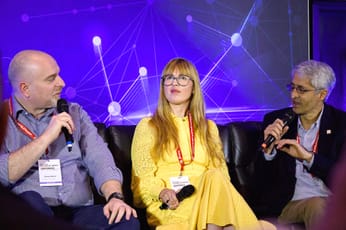#b2bhuddle : Doug Kessler
Doug Kessler, creative director and co-founder, Velocity Partners
This is a hot time to be in B2B – but most people don’t know that. This is a great time to be thinking about the future of content marketing, and we’ve all come a long way. But this is a good time to stop, take a break and get a sense of where this beast is going.
Why should you care about the future? Some of you are at the bottom of the curve, looking at all you have to learn, some of you are at the top, doing cutting edge work. Why worry about the future when there’s so much to worry about in the present?
What is Content Marketing? It’s packaging up your expertise to help your prospects do their jobs better.
“Skate where the puck’s going to be”.
— Wayne Gretsky
That’s why the future matters. I don’t want you to be the guy running down the hall in six months saying “Eureka! I’ve discovered white papers.” They’re dead.
The trend for content marketing is a hockey stick. It’s exploding. You’ll double your output this year. So will your competitors. Everyone’s doing it – this is the megatrend. Everyone’s doing it – search, social, digital agencies. And that’s why we published the thing called Crap – why the single biggest threat to content marketing is content marketing. It went B2B viral. 220,000 views – that’s insane. We touched a nerve. A lot of people are thinking about this. (The attitude, energy and naughty word in the title probably helped.) We weren’t the first to use SlideShare as a medium in itself, but that’s what we did. It’s meant to be self-consumed. It was written as a SlideShare presentation, for that experience.
There are two ways to stand out:
- What you say – we hit on something that mattered
- How you say it – SlideShare
These are the two things we help clients with. The first is the most important. You have to be inside your market and understand what is hot right now. We’re going to look at the second – how you say it. And we’ll use the Five Beyonds.
1. Beyond Gutenberg
We’ve been in the digital world for years. We haven’t done a print project in years, but people get stuck in print thinking: eBooks, White Papers and so on. But most of our consumption is on tablets and other screens. SlideShare is made for the screen. We’re slowly letting go of the handrail of print thinking. And it is a handrail. We know how to communicate this way. Scrolling Sites – every last drop by Water Wise for example. It’s a charming, light screen-based way to tell a story. As new things come along, figure out what stories they’re good for telling. Tablet apps are another example – Together for the WWF.
2. Beyond Search
Up until now everyone has been sacrificing their first born to the Gods of Google. As content increases, search will fail us – there’s just too much of the content. Even terrific content will end up on page 3. The first page is too limited a resource. If we’re dependent on Google, we’ll all end up suffering. How do we replace that? Community? SEOMoz is an example of that. A good piece on content marketing got 1000s of shares – because it’s a great community. Build a community, and you’ll become more self-sufficient.
3. Beyond One-Size-Fits-All Content
We put out an eBook – and everyone gets the same one. But we know loads about the people coming to our sites. The beginnings of this are doing some segmentation. But then you have five eBooks. Where do you put them? Well, how about dynamically assemble the content? Adverts are doing this. There’s no ad waiting for you, just a database which assembles an ad. Let’s do that with content. Web content systems can do this, but we need to let go of print thinking.
4. Beyond Teaching
Content tends to teach right now. It just gives people information. The step beyond is using content to do people’s job. The Citrix Project Accelerator addresses the huge demand on their consulting resources. They harnesses knowledge from their consultants, and built a tool that allowed customers to run the virtualisation journey on their own. It makes the project manager’s job easy. They made a mistake, though. They used content marketing to promote this – and ran ads. The ads outperformed – because this is content. They just needed to get out of the way and let people know it exists. They produced a Content Marketing Strategy checklists that is a way of generating your won strategy.
5. Beyond the Faceless Brand
Social Media has been around a long time – and it’s all about people. Faces are beginning to be attached to companies. We’re seeing the rise of the B2B rock stars – personal content brands that associate with company brands. It’s good because it can power your brand – and bad because they can leave… Google is rewarding this with author profiles and rel=author
It’s all part of the rise in authenticity. Marketing used to be largely bullshit. Now, people are seeing things because the company is porous. You can’t be the only voice of the company people here. So you need to change what you do before you can talk about it. The Simon Sinek TED talk is worth watching.
They ran into some bad SEOs early on, who enthused about keyword-packed content. They hated how it appeared, so they wrote for people rather than spiders – and that has been great in the age of the Panda update.
Underneath this all is another beyond. The culture change necessary to make things work underlies this. So:
Beyond yesterday’s culture
The ones who are succeeding are the one who are good at taking the rest of the company along with them. This touchy-feely stuff around culture is more important than much of the hard stuff. Marketeers are the best people to lead this, and not doing it feels like an abdication of responsibility.
The best way to predict the future is to create it
-Abraham Lincoln
Questions and Answers
How far can personalisation go? Should you expose the mechanism? It can be spooky if you don’t. People resist personalisation for the creepy factor, and the suspicion that if the personalisation is wrong, and you’re missing something. In the end, you’re working stages to a segmentation of one. Fuse Meeting followed him all around the web – as did his clients. He wanted to opt out, but he couldn’t opt out of just one bit of personalisation.
Can you use retargeting to bring people to their content? If you retarget, you have to frequency cap. Fuse was showing me things 80 or 90 times, and paying all the time, They should have stopped by 20. It can be used, but it needs to be used intelligently from ROI and sensitivity perspective.
**If people are brands, then business need to recruit differently, right? **Yes, businesses need people that have social profile and fit the brand. We love people who are blogging and acting as a good social citizen. People who are jerks online won’t get hired even if they’re great at their jobs.
What’s the relationship between CRM and social CRM? Social CRM is core to this. CRM that isn’t social is stone age. You’re going to ignore what they’re saying on social channels? That’s insane. It’s light and lose, but you should be tracking it. It can be creepy, but it’ll be malpractice not to plug it into your CRM.
Can you over-personalise? Yes. Serendipity is a huge power. Smart personalisation will throw in wildcards. Let’s keep some serendipity in there. And let people choose the less personalised route. If they want to be in browse mode, they should be able to.
Could the cost of personalised content slow down the rush towards crap? It will be an inhibitor – but it won’t be anything compared to the tidal wave. Tools will make it cheaper – marketers have a way of ruining everything. What will slow the tide is when content stops working. That will be a bigger break on the wave. Cost of production is always driven down.
Sign up for e-mail updates
Join the newsletter to receive the latest posts in your inbox.













